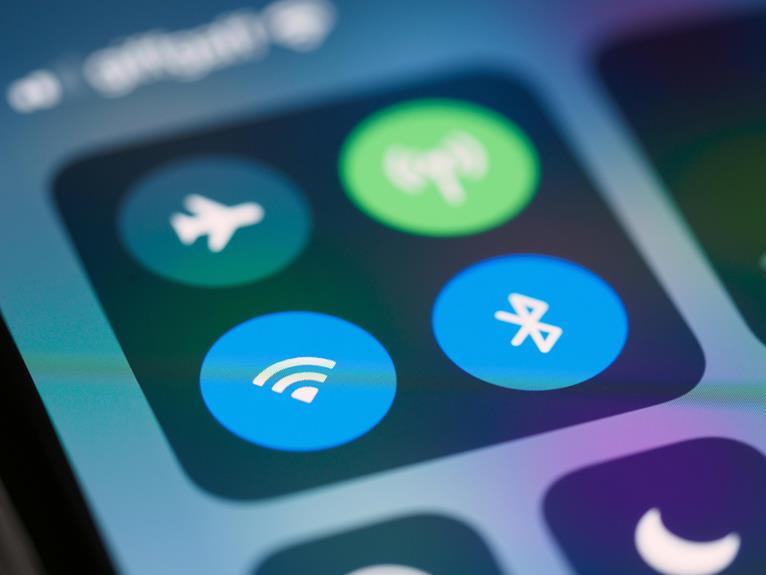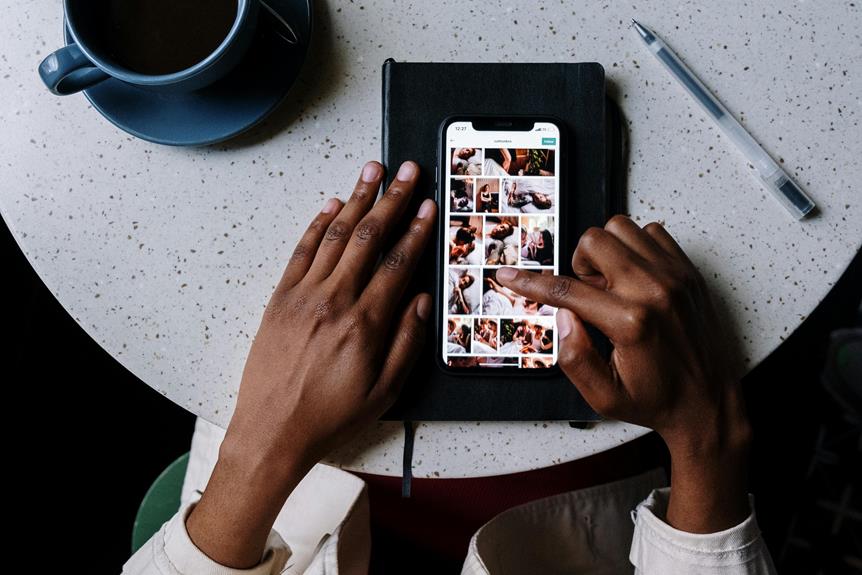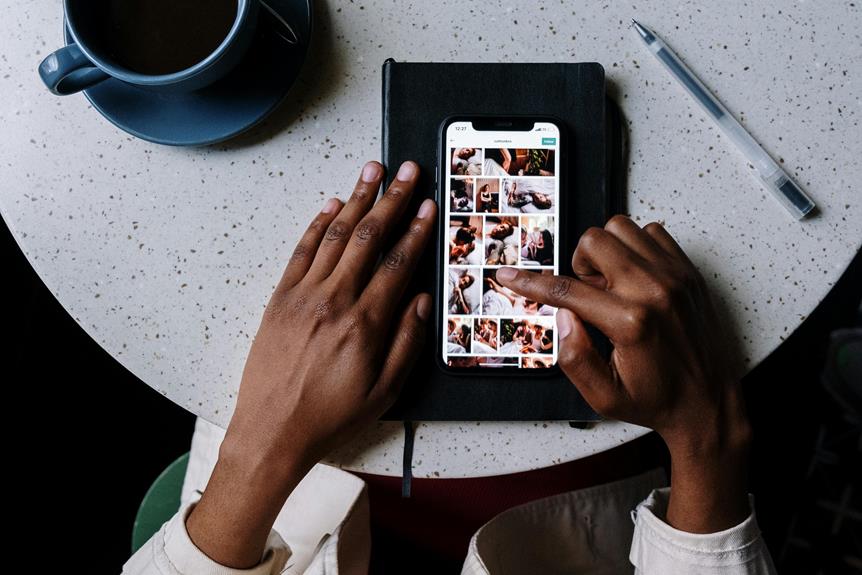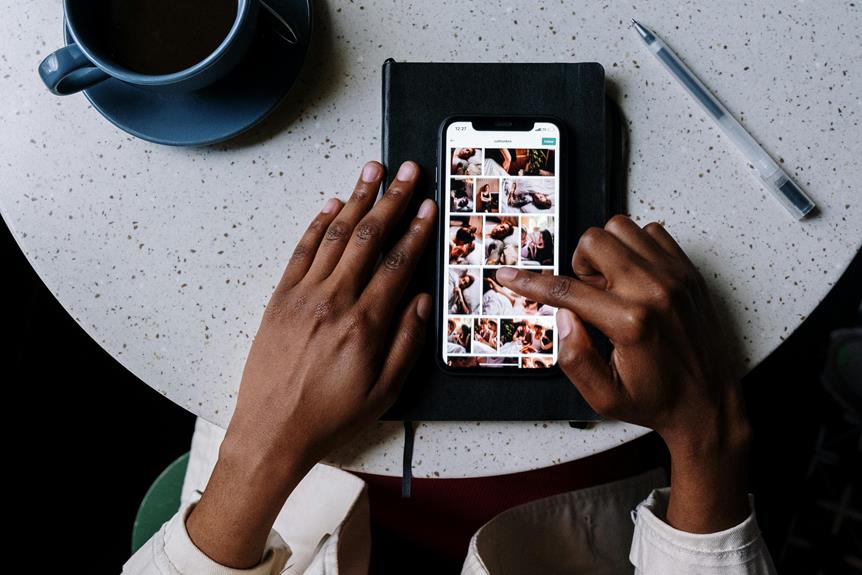10 Best Ios 18 Hidden Features
As a heavy iOS user, I've discovered that iOS 18 has a plethora of hidden features that can markedly enhance my iPhone experience. I've found advanced camera capabilities, such as Macro Photography and Low Light Mode, which greatly improve photo quality. Back Tap allows me to customize double or triple tap actions, while Accessibility features like Enhanced Focus Mode Options and AssistiveTouch provide more intuitive control. I've also learned how to customize my Home Screen layout and optimize my iPhone storage. From Custom Silent Mode to Safari Browser Productivity Tools, I've only scratched the surface of what iOS 18 has to offer.
Key Takeaways
- Customize your iPhone experience with Focus Mode, which filters notifications and adjusts layouts based on activity or environment.
- Utilize the Back Tap feature to perform custom actions like opening apps or taking screenshots with double or triple taps.
- Improve productivity with Safari's Tab Group Management, which organizes tabs by topics or projects for simplified navigation.
- Enhance your camera experience with Macro Photography, Low Light Mode, and Portrait Mode Enhancements for better photo quality.
- Personalize your Home Screen with customization options like icon size adjustment, hiding home screens, and widgets.
Unlocking Ios 18 Hidden Modes
I discovered three hidden modes within iOS 18 that greatly enhance the iPhone experience. These modes can be activated using secret gestures and are designed to provide users with enhanced security, productivity, and accessibility.
The first mode is Back Tap, which allows users to double or triple tap the back of their iPhone to perform custom actions such as opening apps, taking screenshots, or locking the device. This feature can be accessed by maneuvering to Settings > Accessibility > Touch > Back Tap.
The second mode is AssistiveTouch, a feature that allows users to access system shortcuts and multitasking options from a floating menu. This feature can be activated by maneuvering to Settings > Accessibility > Touch > AssistiveTouch.
The third mode is Focus, a feature that allows users to customize their iPhone experience based on their current activity or environment. Focus modes can be customized to filter notifications, modify home screen layout, and adjust system performance. This feature can be accessed by maneuvering to Settings > Focus.
Customizing Home Screen Layout
Customizing my home screen layout in iOS 18 has been a game-changer, allowing me to personalize my iPhone experience. I can change the icon size to better suit my needs, hide home screens that I don't use frequently, and rearrange my app layout for improved organization. By exploring these features, I've been able to create a more streamlined and efficient home screen that enhances my overall iOS experience.
Change Icon Size
With iOS 18, you can now change icon size on your home screen, offering a more flexible and personalized experience. This feature allows you to customize the layout of your home screen to fit your size preference settings.
You can use the following icon adjustment techniques to change icon size:
- Go to Settings, then Display & Brightness.
- Tap on Home Screen.
- Select either 'Standard', 'Compact', or 'Zoomed' to adjust the icon size.
- You can also use the 'Zoom' option to further customize the size of your icons.
Changing the icon size can greatly impact the overall look and feel of your home screen. By adjusting the size of your icons, you can make better use of the available space and create a more organized layout. Additionally, you can experiment with different size settings to find the one that suits your needs best. With iOS 18, you have more control over your home screen than ever before, and changing icon size is just one of the many features that allows you to customize your experience.
Hide Home Screen
Within iOS 18, you've gained more control over your home screen layout, including the ability to hide entire home screens. This feature gives you more flexibility in organizing your apps and widgets. To hide a home screen, long press on an empty area of the home screen until the icons start jiggling, then tap the dots at the bottom of the screen to view all your home screens. From there, you can tap the checkmark below each home screen to hide or show it.
| Reasons to Hide | Benefits | Tips |
|---|---|---|
| Reduce clutter | Streamline app drawer organization | Hide home screens with infrequently used apps |
| Simplify home screen | Improve navigation | Use home screen widgets to access important info |
| Enhance security | Hide sensitive apps from view | Hide home screens with private apps or data |
| Free up space | Make room for new apps or widgets | Review and hide unused home screens regularly |
| Customize layout | Create a more personalized experience | Experiment with different home screen layouts |
Rearrange App Layout
One area where iOS 18 truly shines is in allowing me to fine-tune my home screen layout. The ability to rearrange app layout is essential for maximizing productivity and streamlining my app organization tips. With iOS 18, I can easily customize my home screen to fit my needs, ensuring that my most frequently used apps are easily accessible.
To optimize my layout, I follow these layout optimization strategies:
- Group similar apps together: I categorize my apps by type, such as social media, productivity, and entertainment, to quickly locate related apps.
- Prioritize frequently used apps: I place my most frequently used apps in the dock or on the home screen for easy access.
- Utilize widgets: I use widgets to display important information, such as weather or calendar events, without having to open an app.
- Create a 'junk drawer': I designate a folder or screen for apps that I don't use frequently, keeping my home screen clutter-free.
Using Advanced Camera Features
Several advanced camera features in iOS 18 can take my mobile photography to the next level. One of these features is macro photography, which allows me to capture stunning close-up shots of small objects. To get the best macro shots, I can use a tripod and the Ultra Wide-Angle lens to minimize camera shake. I can also use the Camera app's built-in macro photography tips, which provide guidance on composition and lighting.
In low light environments, I can use the Low Light mode to capture brighter and more detailed photos. This mode uses advanced noise reduction and multi-frame image processing to produce better results. Additionally, the Night mode settings can be customized to adjust the exposure time and ISO for ideal results.
Other advanced camera features in iOS 18 include Portrait mode enhancements, such as advanced bokeh effects and improved subject detection. Burst mode tips can help me capture the perfect shot by taking multiple photos in rapid succession. The Camera app also offers shortcuts for quick access to common modes and settings.
When it comes to video recording, I can use the Live Photos tricks to create interactive and immersive experiences. Slow motion settings can add drama and emphasis to my videos, while video stabilization options can help reduce camera shake and produce smoother footage. With these advanced camera features, I can take my mobile photography to new heights.
Quick Actions With Back Tap
In iOS 18, I can customize my iPhone's Back Tap feature to perform various quick actions. This feature allows me to set specific actions for both Double Tap and Single Tap on the back of my iPhone. By customizing these options, I can streamline my interactions and access frequently used features more efficiently.
Customizable Double Tap
Frequently, users overlook the Back Tap feature that allows for customizable double and triple tap actions. With the Customizable Double Tap feature in iOS 18, you can take advantage of double tap gestures to streamline your iPhone experience.
To access this feature, go to Settings > Accessibility > Touch > Back Tap. Here, you can assign specific actions to double or triple tap gestures. You can choose from the following options to customize your double tap actions:
- Siri Shortcuts: Assign double tap actions to custom Siri shortcuts, allowing you to access frequently used tasks with ease.
- App shortcuts: Launch frequently used apps with a double tap, eliminating the need to navigate through your home screen.
- System actions: Use double tap actions to access system features such as the Home screen, Lock screen, or Notification Center.
- Accessibility features: Assign double tap actions to accessibility features such as Magnifier, Flashlight, or Reachability.
Single Tap Options
My iPhone's Back Tap feature just got even more powerful with the addition of single tap options in iOS 18. This enhancement brings more flexibility to the existing double-tap feature, allowing users to quickly access various actions with a single tap on the back of their iPhone. With single tap options, you can create custom shortcuts, interact with accessibility features, and more.
Here's a breakdown of the single tap options available in iOS 18:
| Single Tap Action | Description | Accessibility Feature |
|---|---|---|
| Lock Screen | Locks the iPhone screen | Yes |
| Notification Center | Opens Notification Center | Yes |
| Control Center | Opens Control Center | Yes |
| Screenshot | Takes a screenshot | No |
| Accessibility Shortcut | Activates the Accessibility Shortcut | Yes |
I've found the single tap options to be particularly useful when it comes to single tap accessibility features. With the Accessibility Shortcut, you can quickly activate features like AssistiveTouch, Switch Control, or Zoom with a single tap. This feature can be especially helpful for users who rely on these accessibility features to navigate their iPhone. Overall, the addition of single tap options in iOS 18 is a welcome enhancement to the Back Tap feature.
Ios 18 Accessibility Features
As I investigate the new features of iOS 18, I'm excited to explore the updates to accessibility features that can greatly enhance the user experience for individuals with disabilities. iOS 18 offers a wide range of features that cater to different needs, from visual and hearing impairments to physical and motor disabilities.
One of the key features is the improved text to speech functionality, which allows users to customize the reading experience with different voices, speeds, and languages. Additionally, voice control has been enhanced, enabling users to interact with their device using voice commands.
Here are some of the notable accessibility features in iOS 18:
- Enhanced Magnification Tools: iOS 18 offers improved magnification tools, including zoom, inverted colors, and color filters, making it easier for users with visual impairments to navigate their device.
- Advanced Gesture Navigation: Gesture navigation has been refined to provide a more intuitive experience for users with motor disabilities, allowing them to customize gestures to suit their needs.
- Improved Auditory Descriptions: iOS 18 provides detailed auditory descriptions for visually impaired users, making it easier for them to understand and interact with their device.
- Sound Recognition: The Sound Recognition feature in iOS 18 can detect and alert users to specific sounds, such as doorbells, sirens, or animals, helping users with hearing impairments to stay aware of their surroundings.
Other notable features include assistive touch, haptic feedback, and reading options, which can be customized to meet the individual needs of users with disabilities. Overall, iOS 18 offers a robust set of accessibility features that can greatly enhance the user experience.
Advanced Notification Management
Managing notifications on iOS devices has always been a crucial aspect of mobile productivity. iOS 18 takes notification management to the next level with advanced features that let me fine-tune my notification experience. One of the standout features is notification prioritization, which allows me to assign different priority levels to various apps and conversations. This way, I can guarantee that critical notifications from important contacts or apps appear at the top of my notification list, while less important ones are relegated to the bottom.
Another feature that I find particularly useful is the ability to customize silent mode. In iOS 18, I can set specific times when I want my device to be in silent mode, and even choose which notifications can break through during that time. This means that I can silence notifications during meetings or when I'm in a quiet environment, but still receive critical notifications from important contacts or apps.
I can also customize the notification settings for individual apps, allowing me to control the type of notifications I receive, the frequency of notifications, and even the notification tone. This level of customization is a significant improvement over previous iOS versions, and it has greatly enhanced my overall notification experience. With iOS 18's advanced notification management features, I have complete control over my notification experience, allowing me to stay focused and productive throughout the day.
Enhanced Focus Mode Options
iOS 18's Enhanced Focus Mode Options take a more personalized approach to minimizing distractions. With these focus mode enhancements, I can tailor my iPhone experience to fit my unique needs and preferences, giving me a significant productivity boost.
The new Focus Mode Options menu provides an array of customization possibilities. Here are some of the key features:
- Customizable Focus Filters: I can now choose which apps and features are available when a Focus mode is enabled, allowing me to focus on specific tasks without unnecessary distractions.
- Scheduled Focus Modes: I can schedule different Focus modes to turn on and off at specific times of the day or based on my location, helping me stay on track and avoid multitasking.
- Focus Mode Reminders: I can set reminders to turn on Focus modes at specific times, such as during work hours or when I'm in a meeting, ensuring I stay focused on the task at hand.
- Focus Mode Customization: I can create custom Focus modes tailored to specific activities, such as reading or gaming, and assign them to specific apps or features.
These enhancements allow me to fine-tune my iPhone experience and create a distraction-free environment that fosters productivity. With the ability to customize Focus modes to suit my needs, I can stay focused on what matters most.
Safari Browser Productivity Tools
I've discovered two Safari browser features in iOS 18 that greatly boost productivity: Tab Group Management and Private Browsing Mode. These tools enable me to efficiently organize my browsing sessions and maintain online privacy. By leveraging these features, I can streamline my workflow and minimize distractions while browsing on my iPhone.
Tab Group Management
Several features in Safari's Tab Group Management make it easier to organize and access related content on the go. As someone who frequently works on multiple projects simultaneously, I appreciate the ability to categorize and manage my tabs more efficiently.
Here are some key benefits of Tab Group Management:
- Tab organization tips: Easily create and manage tab groups based on specific topics or projects, allowing me to quickly switch between related content.
- Group sharing options: Share entire tab groups with colleagues or friends via a simple link, streamlining collaboration and information sharing.
- Customizable group names: Personalize tab group names to better reflect their content, making it easier to identify and access specific groups.
- Quick tab group switching: Seamlessly switch between tab groups using the tab bar or keyboard shortcuts, reducing the time spent maneuvering between related content.
Private Browsing Mode
My productivity workflow often requires handling sensitive information, which makes Private Browsing Mode a valuable feature in Safari's Browser Productivity Tools. With this mode, I can browse the web without leaving any digital footprints, such as browsing history, cookies, and search history. To enable Private Browsing Mode, I simply tap the "Tabs" icon in Safari, then tap "Private" to switch to a private browser window. I can also use the "Private" tab in the Control Center to quickly toggle Private Browsing Mode on and off.
In Private Browsing Mode, Safari uses private browser settings that prevent websites from tracking my browsing activity. This mode also prevents Safari from storing my browsing history, which adds an extra layer of security. For incognito browsing tips, I recommend using Private Browsing Mode when shopping online or accessing sensitive information. Additionally, I can use the "Ask Websites Not to Track Me" feature in Safari's settings to further protect my online privacy. By using Private Browsing Mode and these incognito browsing tips, I can safeguard my online activity and maintain my productivity workflow.
Iphone Storage Optimization Tips
While managing your iPhone's storage capacity can seem intimidating, it's vital for maintaining ideal device performance. As we store more data on our devices, it's important to optimize storage to guarantee seamless functionality.
I've found that adopting a few storage optimization strategies can make a significant difference. Here are four methods I use to manage my iPhone's storage:
- Regularly review and delete unused apps: I go through my apps and delete those I no longer use or need. This not only frees up storage space but also reduces clutter on my home screen.
- Use cloud storage for photos and media files: I use cloud storage services to store my photos and media files, which helps reduce the amount of storage space they occupy on my device.
- Enable file compression and optimize storage settings: I enable file compression to reduce the size of my files, and I also optimize my storage settings to guarantee that my device is using the most efficient storage options.
- Clear cache and organize documents: I regularly clear my cache to get rid of temporary files that can take up a significant amount of storage space. I also organize my documents and files to guarantee they're easily accessible and not taking up unnecessary space.
Hidden Gestures and Shortcuts
Mastering iOS 18's hidden gestures and shortcuts can greatly enhance my iPhone experience, allowing me to perform tasks more efficiently and effectively. Gesture navigation is an essential aspect of iOS 18, and learning the various swipe actions and multitasking gestures can revolutionize how I interact with my iPhone. For instance, I can quickly switch between open apps by swiping left or right on the home screen or using the app switcher.
iOS 18 also offers shortcut customization, allowing me to create custom shortcuts using the Shortcuts app. This feature enables me to combine multiple actions into a single gesture shortcut, making it easier to access my favorite features. For example, I can create a shortcut to send a message to a specific contact or to open a frequently used app.
Quick access to frequently used features is also possible through hidden shortcuts, such as swiping up from the bottom of the screen to access the app switcher or Control Center. Additionally, I can use screen interactions like the "back tap" feature, which allows me to double or triple tap on the back of my iPhone to trigger custom actions. By learning and utilizing these hidden gestures and shortcuts, I can take full advantage of iOS 18's capabilities and streamline my iPhone experience.
Conclusion
I've explored iOS 18's best-kept secrets, and now you can reveal their full potential. With each hidden feature, I've discovered a new way to customize, a new way to create, and a new way to streamline my iPhone experience. I can personalize my home screen, release advanced camera capabilities, and tap into quick actions. Whether I'm optimizing storage, using Safari tools, or enhancing focus, I'm in control – and now, so are you.
Share this content:







Post Comment